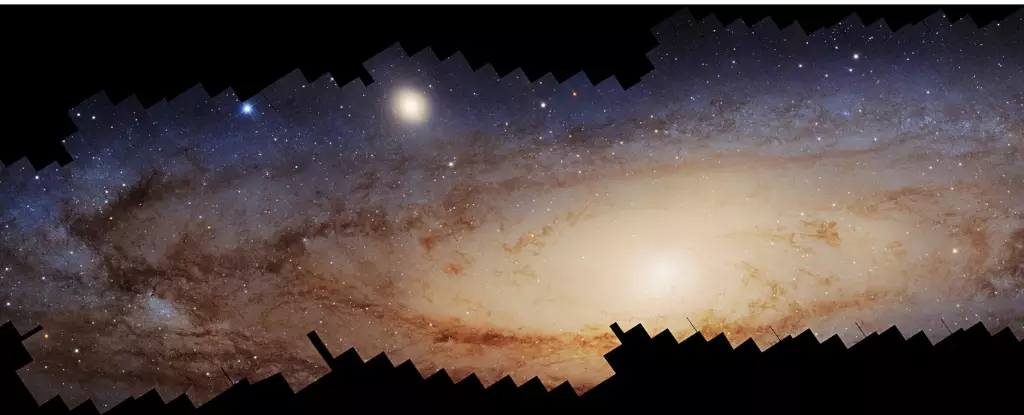The Andromeda Galaxy, designated as M31, occupies a unique position in the cosmic landscape as our closest spiral galaxy neighbor. Situated approximately 2.537 million light-years away, it stands in stark contrast to the vast emptiness of space, serving as a significant focal point for astronomers seeking to better understand not just itself but also our home galaxy, the Milky Way. This article delves into the multifaceted nature of Andromeda, the implications of recent observations, and the prospects for future research that promise to deepen our comprehension of galactic evolution.
Despite its proximity, Andromeda can often appear as nothing more than a faint gray smudge in the night sky. This nebulous appearance belies its grandeur and complexity, making it one of the farthest celestial objects visible without a telescope. The advent of powerful observational tools has transformed our understanding of M31, enabling astronomers to capture stunningly detailed images of this barred spiral galaxy. The Hubble Space Telescope, for example, compiled a breathtaking 2.5-gigapixel mosaic encapsulating approximately 200 million stars, each more luminous than our Sun. However, this vast dataset only scratches the surface of Andromeda’s stellar population, as dimmer red dwarf stars remain largely undetected.
Observations of Andromeda present crucial data for understanding both its structure and that of our own galaxy. Researchers like Ben Williams from the University of Washington emphasize that studying M31 allows scientists to assess various galactic phenomena without many of the complications that arise when observing more distant galaxies. Such advantages include minimized line-of-sight reddening and a clearer context for understanding the interstellar medium (ISM) structure and star formation rates.
The data captured through two significant observational programs—the Panchromatic Hubble Andromeda Treasury (PHAT) and its southern counterpart, the Panchromatic Hubble Andromeda Southern Treasury (PHAST)—have enhanced our understanding of the galaxy’s characteristics. Findings indicate that Andromeda serves as an exemplary model for comparative studies with the Milky Way, offering insights into stellar populations, gas metallicity, and star formation activity.
One noteworthy finding from these extensive observations is the distinct characteristics of Andromeda’s southern disk. Preliminary analyses reveal that this region is more disturbed than its northern counterpart, which may correlate with Andromeda’s tumultuous merger history. The presence of M32, an early-type dwarf galaxy, provides hints regarding past galactic collisions that could have significantly altered Andromeda’s structure. Researchers speculate that M32 might be the remnant core of a previously larger galaxy consumed by Andromeda—events that have shaped its current configuration.
The Giant Southern Stream, a tidal debris stream comprising stars in Andromeda’s halo, serves as further testament to its violent history. The lower metallicity of stars within this stream compared to those in the main galaxy suggests an interaction with a separate galaxy, corroborating theories of Andromeda’s merger events over billions of years.
Through advanced imaging and photometric studies, astronomers are beginning to characterize Andromeda as a transitional type of galaxy—a cosmic hybrid poised between an actively star-forming spiral and a more quiescent elliptical galaxy dominated by aging stars. This dual nature is further highlighted by the presence of a central bulge packed with older stars, juxtaposed with a star-forming disk that exhibits relatively moderate activity. Such observations will enable astronomers to piece together Andromeda’s past mergers and interactions, akin to solving a cosmic puzzle.
As exciting as current findings are, the horizon looks even brighter with the upcoming launch of NASA’s Nancy Grace Roman Space Telescope. Designed with advanced infrared capabilities and an expansive field of view, it promises to enhance our observational power dramatically. Capable of capturing images equivalent to hundreds of high-resolution Hubble views in a single exposure, the Roman telescope will facilitate in-depth studies of features like the Giant Southern Stream.
The Andromeda Galaxy remains an invaluable asset in our quest to understand not just its own mysteries but also those of our Milky Way. Each new discovery enriches our cosmic narrative and underscores the interconnectedness of galaxies in the universe. As we stand at the precipice of new observational technologies, the future promises even greater revelations about our galactic counterparts and the forces that shape them.


Leave a Reply